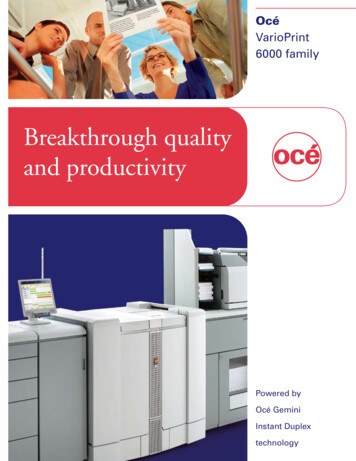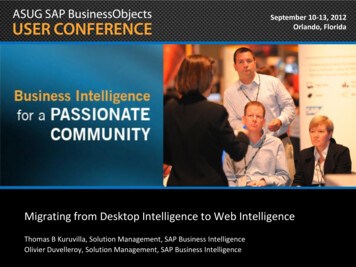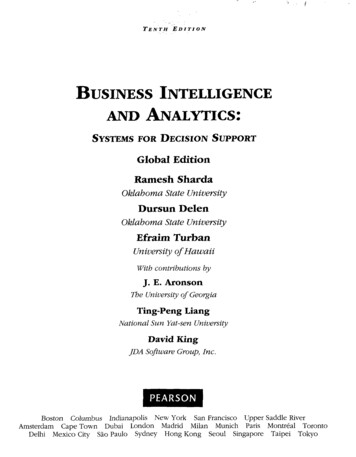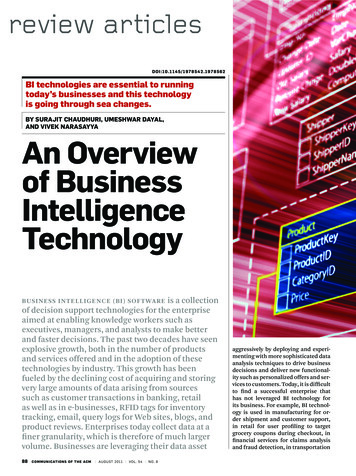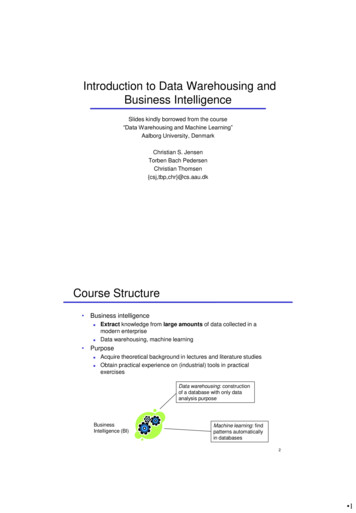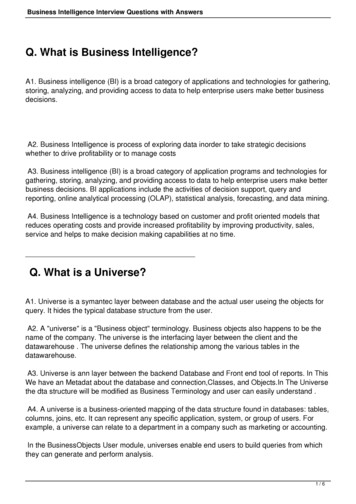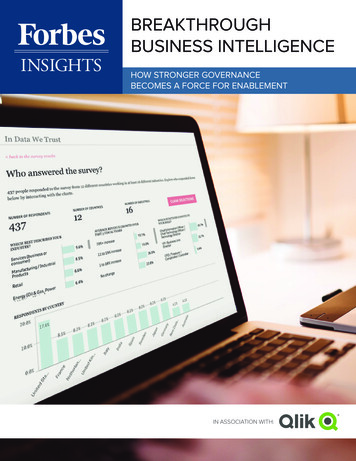
Transcription
BREAKTHROUGHBUSINESS INTELLIGENCEHOW STRONGER GOVERNANCEBECOMES A FORCE FOR ENABLEMENTIN ASSOCIATION WITH:
CONTENTSIntroduction/Key Findings . . . . . . . . . . . . . . . . . . . . . . . . . . . . . . . . . . . . . . . . . . . . . . . . . . . . . . . . . . . . . . . . . . . . . . . . 2Part One: Companies Are Reporting Significant Benefits From Their BI Programs . . . . . . . . . . . . . . . . . . . . . . . . . 4CASE STUDY—CA Technologies: Look Forward and Outward (Not Inward and Backward) . . . . . . . . . . . . . . . . . . 7Part Two: But There’s Much More to Be Done to Improve Business via BI . . . . . . . . . . . . . . . . . . . . . . . . . . . . . . . .8CASE STUDY—Bajaj Auto: Using Data to Deliver Remarkable Results . . . . . . . . . . . . . . . . . . . . . . . . . . . . . . . . . . . 11Part Three: Improving BI: The Key Catalyst Is Governance . . . . . . . . . . . . . . . . . . . . . . . . . . . . . . . . . . . . . . . . . . . . . 12CASE STUDY—MTS Sensor Technologies GmbH & Co. . . . . . . . . . . . . . . . . . . . . . . . . . . . . . . . . . . . . . . . . . . . . . . . 12CASE STUDY—Singapore Management University: Determining Which Data Is Useful . . . . . . . . . . . . . . . . . . . . .15Part Four: Conclusion: Governance Enables Success . . . . . . . . . . . . . . . . . . . . . . . . . . . . . . . . . . . . . . . . . . . . . . . . . 16Methodology . . . . . . . . . . . . . . . . . . . . . . . . . . . . . . . . . . . . . . . . . . . . . . . . . . . . . . . . . . . . . . . . . . . . . . . . . . . . . . . . . . . . 17Acknowledgments . . . . . . . . . . . . . . . . . . . . . . . . . . . . . . . . . . . . . . . . . . . . . . . . . . . . . . . . . . . . . . . . . . . . . . . . . . . . . . . 17
INTRODUCTIONIn research conducted by Forbes Insights, organizations report that they are obtaining breakthrough returnsfrom investments in business intelligence (BI). BI solutions are embedded throughout industry leaders acrossthe world. Meanwhile, with so many more data and self-service analysis solutions at their fingertips, executivesand their reports are being transformed from mere managers to true information workers. The success of theseprograms is yielding substantial benefits, both tangible and intangible.But despite such positive results, executives nonetheless recognize that there’s much more to be achieved.Companies today are concerned they may be leaving too much potential BI-generated performance on thetable; fewer than half feel they are gaining full benefit from their programs. In particular, executives report that avariety of issues remain a concern. Key among these: less than optimal adoption rates, lingering silos, multiple“versions of the truth” and security.The way forward? It may sound counterintuitive, but to achieve breakthrough performance in harnessinginsights from data, companies need to pay closer attention to data governance. Stronger governance helpsensure not only consistent but also reliable and optimized results. This in turn delivers stronger data-drivenperformance, leading to even greater awareness, momentum and adoption.The challenge: developing governance processes that can co-exist with the need for greater data access andflexibility among distributed knowledge workers.2 BREAKTHROUGH BUSINESS INTELLIGENCE
KEY FINDINGSBI programs are today delivering remarkable business results. Four out of five organizations (81%) report thatthey are experiencing “very significant” (45%) or significant (36%) business benefits from their BI programs.These findings are consistent across industries and geographies.But as effective as BI can be, a range of issues continue to plague the realization of its full potential, includinginconsistent data, multiple versions of the truth, inconsistent formulas/definitions and limited adoption acrossthe enterprise. The common thread: all can be addressed via better governance.As a result, less than half of survey respondents (48%) feel their current approach is yielding full advantage ofthe business improvement opportunities afforded by BI.In terms of benefits to date from BI, in three out of four cases, respondents say they are realizing a mix oftangible and intangible benefits—in both instances substantial. The benefits also span a wide range of organizational activities and business processes. These include improved customer metrics, accelerated time tomarket, stronger product and service mixes, enhanced brand valuation and recognition, and higherprofitability.Executives recognize the importance of governance in BI, as over three-quarters (78%) say data governanceis either vital or important to their BI operations, and 65% say governance is a useful means to empowerend-users to uncover new insights.Most say they are taking important steps in governance, with 83% managing data access at the departmentallevel, 81% assigning data access by role, and 76% mandating the use of specific BI solutions and dashboards.Though such actions may moderate BI, in the broader context of operations, they tend to improve overalloutcomes.Fifty-seven percent agree or strongly agree that end-users who acquired or developed their own BI systemsindependent of a centralized BI or IT function are today turning to centralized IT or BI departments forenhanced governance. This is yet another indication of the importance of governance in getting the mostfrom BI solutions.Going forward, the structure of BI will feature:Less IT controlAn increase in standalone, independent BI functionsGreater structure, planning, and governance; fewer ad hoc characteristicsA greater mix of centralized/decentralized approachesAll amid a greater understanding of the vital role of governance in improving—not restricting—the performance of BI.COPYRIGHT 2016 FORBES INSIGHTS 3
I. Companies Are Reporting Significant Benefits From Their BI ProgramsSpeak with a range of executives and each will havetheir own definition of business intelligence (BI). Still,one of the most widely accepted general descriptions comes from Gartner:Business intelligence: An umbrella term thatincludes the applications, infrastructure and tools,and best practices that enable access to and analysisof information to improve and optimize decisions andperformance.1Regardless of the precise definition, BI programs aretoday delivering remarkable business results.Fourout of five organizations (81%) report that they areexperiencing “very significant” (45%) or “significant”(36%) business benefits from their BI programs.Moreover, it doesn’t seem to matter which industry isunder the microscope—the results are still highlypositive. As Qlik’s Mike Saliter, VP of global industrysolutions, explains, “The beauty of analytics is that itdoesn’t matter whether it’s a [sole proprietor] pizzashop, a [large-cap industrial] startup technology company or anything in between: done well, there can bequantifiable benefits in any organization.”Figure 1. Across the full spectrum of industries and countries surveyed, BI delivers significant benefitsBy Industry:By Country:Business or Commercial ance84%Healthcare81%Japan81%Financial Services80%Spain81%Automotive76%US78%Media & Entertainment76%Sweden72%Consumer Packaged Goods75%UK69%Life Sciences74%Energy68%1Gartner IT glossary, http://www.gartner.com/it-glossary/?s Business intelligence4 BREAKTHROUGH BUSINESS INTELLIGENCE
Benefits aboundThe value of intangiblesReported improvements, respondents say, are inthree out of four cases (76%) a mix of tangible andintangible benefits—in both instances substantial.The benefits also span a variety of organizationalactivities ranging from stronger product/servicemixes, enhanced brand valuation/recognition andhigher profitability to improved customer metrics andaccelerated time to market.The true benefits of BI are likely even more significant than most executives are able to measure. “It’srelatively easy to measure how BI can help cut costsand drive revenues. For example, conversion ratesimprove, product cross-selling increases or expenses are reduced,” says Saliter. Far more difficult: placing a value on benefits such as improving productquality or making better decisions faster. Saliterconcludes, “The true business benefits of deliveringgreater business insight into the hands of morepeople—of empowering decision makers faster—islikely far greater than most recognize.”For a strong example, consider New York-basedenterprise software developer CA Technologies.Saum Mathur, SVP, big data analytics & informationmanagement, says that the firm derives “enormousbenefits from our work in BI.” Mathur splits suchbenefits into two key categories, strategic and tactical.In terms of strategic benefits, big data and relatedwork “gives us a clearer idea of which sorts of companies should buy from us; who are the most likelyprospects.” On a tactical level, BI helps the companyidentify specific individuals within each companywho are the most likely buyers or influencers for CATechnologies products and services. Mathur usesdata to sharpen the company’s marketing and salesfocus from “B2B” to “B2I—business to individual.”B2I, says Mathur, reflects a seismic shift as “digitaltransformation brings about the rise of the individual.” In the rise of the “App economy,” traditionalmeans of engaging with B2B customers are disappearing or “gone.” As Mathur continues, whether fora business customer or an individual, “everythinghappens online.” To hold on to a competitive advantage, “companies must arm their sales and marketingwith new strategies that focus on knowing theircustomers as individuals, and reaching them in waysthat will influence these key business decisionmakers to buy.” As such, says Mathur, B2I is far moreprecise, leading to benefits such “as greater salesforce effectiveness and higher conversion rates.”Kai Cheong Lau, CIO of Singapore ManagementUniversity, expresses complete agreement. BI drivesprocess improvements, certainly, but the true valueof BI, says Lau, “is that it can empower an organization to achieve its core objectives.” For SMU, Lauexplains, “the two things that matter most are howwell we deliver our teaching and learning and howeffectively we create new knowledge and research.”BI “helps us break down and continuously refine andimprove our performance against all of the processes that drive those two objectives.”“[BI] helps us break down andcontinuously refine andimprove our performanceagainst processes that driveobjectives.—Kai Cheong LauCIO, Singapore Management UniversityCOPYRIGHT 2016 FORBES INSIGHTS 5
In this sense, says Lau, “BI is an essential and invaluable tool.” BI “leads to better decisions, moreefficient processes and better coordination acrossthe university.” Though performance improvementscan indeed be measured in virtually “every instancewhere we have applied BI [solutions],” overall, “youcannot put a price that would equate with its real,total value.”Similarly, Lau describes how BI is being used toimprove the curriculum for targeted sets of attendees. The university, Lau explains, “gets its studentsfrom many sources.” Using BI, “we can see howdifferent [sets of] students are performing in variousclasses.” From this, “we are able to do a more effective job of aligning classwork to be more appropriatefor specific groups of students.”Benefits from BI for SMU abound. For example,productivity savings range from 30% to 50% inanalyzing student data and meeting statutory reporting requirements, thanks to clearer and moreefficient access to data.Going forward, says Lau, BI is catching on quickly atSMU. Five or six years ago, when the program started, “it was difficult for us to explain the benefits.”Today, however, “we have many champions in the[organization] who are [quite vocal],” and thus, saysLau, “we are expanding our reach, developing moredashboards for more business [units] all the time.”Figure 2. BI drives substantial tangible and intangible benefits7%The benefits of BI are a mix of tangible andintangible benefits—substantial in both cases17%The benefits are primarily tangible76%The benefits are primarily intangibleFigure 3. Where is BI driving results?90%71%69%67%66%61%58%CustomermetricsTime gProduct/service mix6 BREAKTHROUGH BUSINESS ion
CASE STUDYCA TECHNOLOGIES:LOOK FORWARD AND OUTWARD (NOT INWARD AND BACKWARD)Saum Mathur, SVP, big data analytics & information management, at CA Technologies, believes there is no question that companies should be doing more to harness BI insights from their enterprise data. But traps to avoid,adds Mathur, include focuses on purely internal or past data. The value of BI, says Mathur, stems from looking“forward” and “outward.”As Mathur explains, for some products, “historical data may be helpful.” But in technology, “our world changesconstantly.” So while historical enterprise data may be helpful to a degree, where the company derives its realvalue from BI “is through the use of external data, showing us where the market is going.”A key problem with enterprise data is that it can be “limited in its accuracy because the market, customer buyingpatterns and products change so quickly in our industry,” says Mathur. In addition, “it only shows what [a customer] buys or has bought from us.” But the more important questions, says Mathur, are “what are they buying intotal, from all sources, and what do they actually need?” CA Technologies knows the traits of those most likelyto buy its products. So by harnessing and analyzing external data, the company can build a more completepicture of business at large in order to better identify, prioritize and target likely prospects.“[Enterprise data] only shows what [a customer] buys or has bought from us.” [The moreimportant questions are] “what are they buying in total, from all sources, and what dothey actually need?”—Saum MathurSVP, Big Data Analytics & Information Management, CA TechnologiesSuch analysis looks at current sales, but also develops a snapshot of a prospect’s propensity to buy based ontheir strategies, interests and buying patterns. By taking a look “at their demand side—what are they procuring?”for example, Mathur’s team is able to identify growth before it translates into published revenue or income statements. Similarly, CA Technologies combs through external data sources such as social media data to identifysurges in interest and intent to purchase in any given company, often a signal of growth in the works. (Note: thesurvey shows 42% respondents using social media in their BI programs, rising to 55% over the next 18 months.)Overall, says Mathur, businesses that are experiencing strong growth, participating in the "App economy,"and/or are undergoing digital transformation tend to be solid candidates for the company’s products. Consequently, “we seek to build the whole picture to see if they fit the profile to be a buyer of our products andimprove our targeting.”Figure 4. Social media on the riseNowNext 18 months18%12%Not At All15%12%25%21%2323%37%419%18%5 ExtensivelyCOPYRIGHT 2016 FORBES INSIGHTS 7
II. But There’s Much More to Be Done to Improve Business via BIAs positive as the preceding news may first appear,the fact is, companies still have a long way to go ifthey hope to extract optimal value from BI. There’sno question that today’s programs are deliveringsignificant value. Nonetheless, the survey and theinterviews highlight an array of shortcomings.For starters, less than half of survey respondents(48%) feel their current approach is yielding fulladvantage of the business improvement opportunities afforded by BI.Figure 5. Less than half are gaining full advantage of the business improvement opportunities afforded by BIBy Country:By Industry:EnergyMedia & erlands50%53%Financial S46%Consumer Packaged Goods45%UK41%Pharma/life sciences44%Japan42%Public sector/government44%InsuranceTechnology (software)Healthcare8 BREAKTHROUGH BUSINESS INTELLIGENCE64%41%38%ItalySweden33%
The deeper the survey drills, the more shortcomingsare revealed. For example, companies report:Difficulty accessing data Less than half (46%) sayline-of-business leaders, business analysts,customer-facing employees and those similarlyplaced to create value for the business haveunencumbered access to all of the data and solutions they need. Essentially, over half are sayingmore attention is needed.Lack of access to solutions Three out of five, 63%,say they need to take more steps to place moredata and analysis solutions in the hands of decision makers.Limited views into the business A mere 38%agree or agree strongly (31% and 7%, respectively)that their current set of BI solutions provides theirbusiness units with a complete picture of theiroperations. At best, this means 62% of companiesbelieve greater BI resources are needed in awider range of functions and processes. At worst,those failing to express such agreement areindicating that BI as currently practiced could infact be leading to false conclusions based onincomplete data.The issues hampering optimum effectiveness of BIprograms do not stop there. Asked to acknowledgewhether or not their organizations are experiencingsignificant instances of a range of BI obstacles andchallenges, respondents frequently reported:Inconsistent data sources Three out of five companies (61%) say their organization experiencessignificant instances where needed or useful dataisn’t always available. For various reasons, thedata source—which could be anything from asupplier, partner, government agency or relatedbusiness unit—is on again/off again or completelyshuts off.Data silos Fifty-six percent of organizations—risingto 76% and 68%, respectively, among healthcareand financial services firms—report instances whendata is inaccessible or not widely shared. This canbe caused by perceptions that privacy or regulatory issues (such as HIPAA data in healthcare)prevent such sharing. But in truth, says Saliter, “inmost cases, providing self-service BI capabilitieswith governed data will result in greater sharingand use.”Multiple “versions of the truth” Over half, 53%(rising to 68% in media and entertainment and 67%in healthcare) say that their BI processes deliverinconsistent or unreliable conclusions. This is mostoften the result of a lack of BI oversight or governance, leading to different groups using varyingformulas, definitions or datasets—all of which isconfirmed by these findings:Only 45% say they are absolutely certain(26%) or certain (18%) that all BI teams areusing the same data (33% healthcare, 32%media and entertainment, 27% telecom).Only 50% are absolutely certain (34%) orcertain (16%) that all end-users have access tothe latest updates to their datasets.Only 45% are absolutely certain (25%) orcertain (20%) that their teams are using absolutely consistent formulas, definitions andterminology relating to key measures acrossthe enterprise (20% CPG).Incomplete data Nearly as large a percentage(57%) say their BI operations suffer from occasional bouts of incomplete data—a figure increasing to73% among manufacturers.COPYRIGHT 2016 FORBES INSIGHTS 9
Figure 6. Symptoms of less-than-optimal BI61%57%56%53%Inconsistentdata sourcesIncompletedataData silosMultiple “versionsof the truth”Most frequent in inancialservicesM&EHealthcareFigure 7. There is room for significant improvementUsers are readily able to discover, use and buildupon relevant work developed by other users56%Our BI function has strong control of and insightinto our BI processes and solutions54%Our BI function rapidly and capably assimilatesand disseminates techniques, applications,insights, visualizations and related
BUSINESS INTELLIGENCE HOW STRONGER GOVERNANCE BECOMES A FORCE FOR ENABLEMENT. Introduction/Key Findings Part One: Companies Are Reporting Significant Benefits From Their BI Programs CASE STUDY—CA Technologies: Look Forward and Outward (Not Inward and Backward) Part Two: But Th




